Does your marketing involve several people or teams? Looking for a way to collaboratively manage multiple LinkedIn company pages, ad accounts, or assets?
In this article, you’ll learn how to use LinkedIn Business Manager to access and delegate shared work across teams.
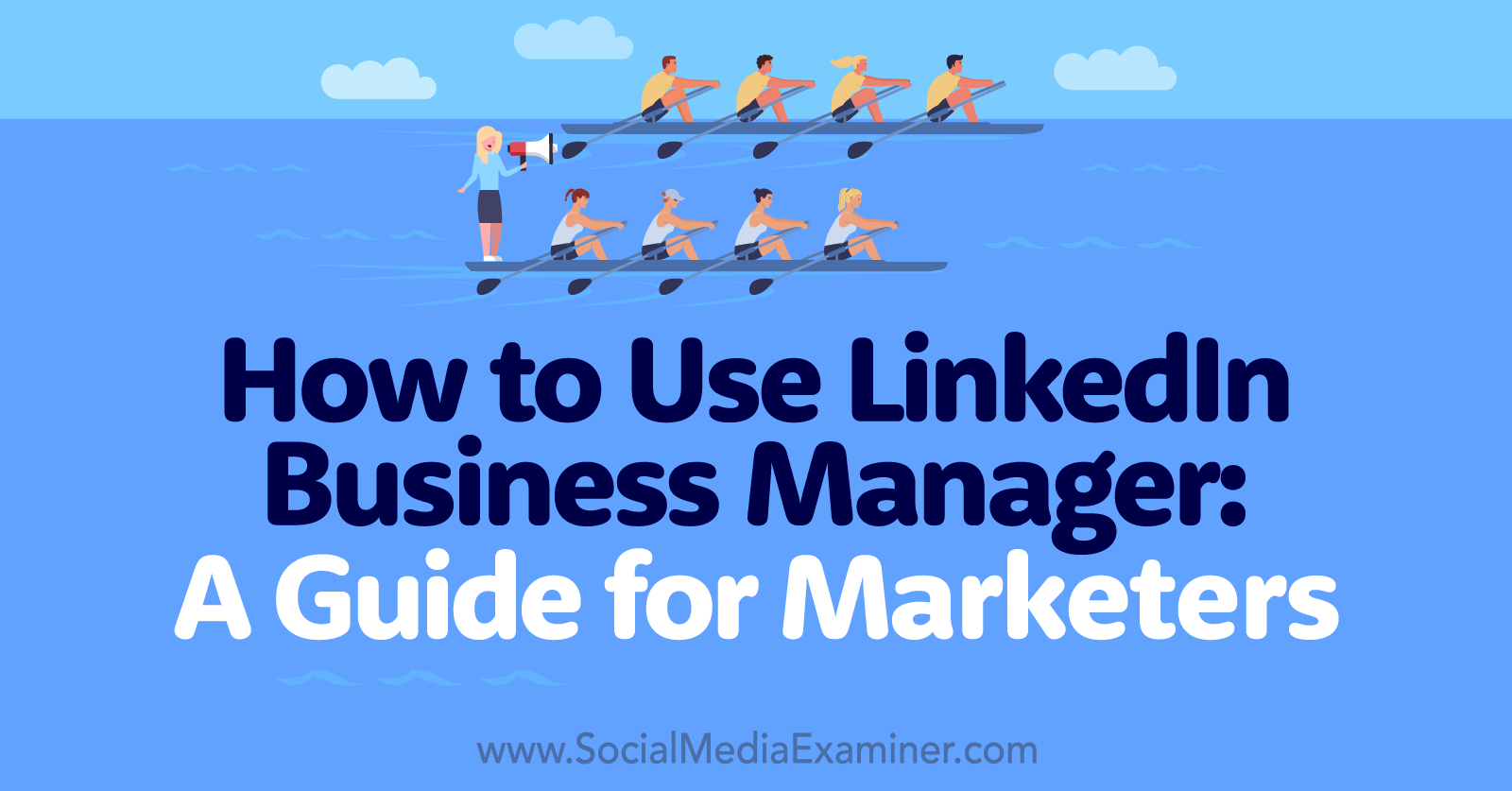
What Is LinkedIn Business Manager?
LinkedIn Business Manager is the social media network’s solution for organizing company assets. It’s a dashboard that lets you manage company pages, ad accounts, matched audiences, and account permissions.
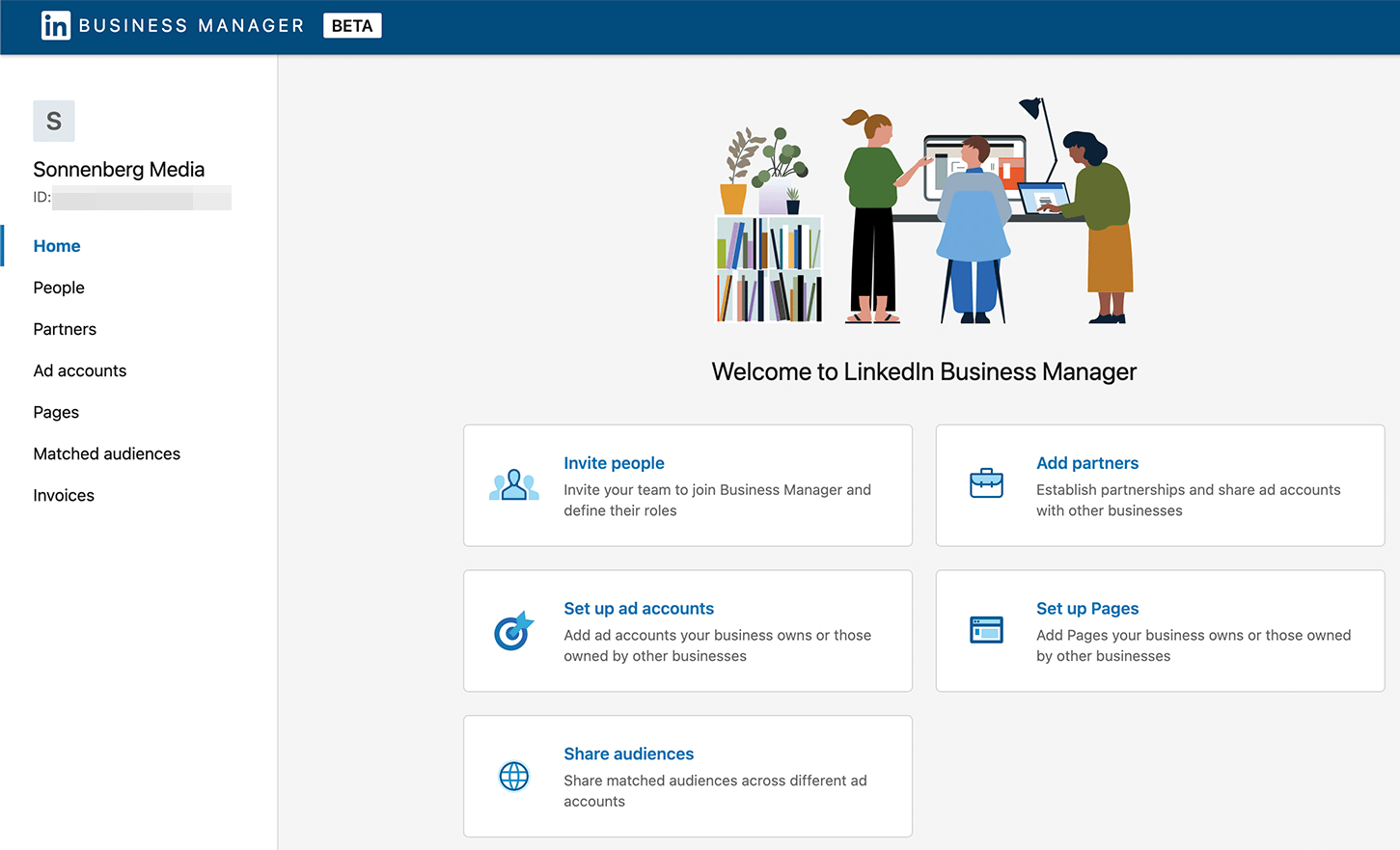
After announcing the dashboard in June 2022, LinkedIn began rolling out the Business Manager platform in July 2022. Since the initial version is a public beta, the network is actively testing tools and features, which means the dashboard is likely to continue to improve and become more useful.
When to Switch to LinkedIn Business Manager
Technically, you don’t have to use LinkedIn Business Manager. As of July 2022, you can still manage your organization’s assets individually by logging into your member profile and navigating to your company page or ad account.
But there are plenty of compelling reasons to start using the Business Manager platform as soon as possible. It’s a good idea to start using Business Manager now if you:
- Manage more than one page and manage ad accounts for your organization. For example, if your organization has company pages, showcase pages, and multiple ad accounts, Business Manager can keep them organized.
- Work with a big team or a lot of stakeholders. With Business Manager, you can more easily grant access and manage permissions—striking a balance between keeping your accounts secure and adding colleagues efficiently.
- Share audiences across ad accounts. Historically, the process for sharing and managing matched audiences has been a little clunky. With Business Manager, you can seamlessly share these audiences across ad accounts.
- Hire agencies and contractors to handle organic social media management or paid campaigns. Business Manager lets you add external partners so you can work together efficiently.
How to Get Started With LinkedIn Business Manager
Let’s dive into the setup process for Business Manager. We’ll go over some suggestions for preparing your Business Manager setup before taking a closer look at the workflow.
#1: Designate a Business Manager Admin
Like any collaborative dashboard for social media, Business Manager can get unwieldy if you’re not careful. If no one’s in charge, everyone’s in charge, which can compromise security and efficiency. Consider designating your organization’s chief marketing officer (CMO) or another high-level marketer as the lead for your Business Manager.
#2: Plan Your Business Manager Structure
If you work for a smaller organization with a straightforward structure, you won’t need to think too much about how to set up your Business Manager. Instead, you can simply add your pages and ad accounts to a single Business Manager dashboard.
But if you work for a national or global organization with multiple units or regions, setting up your Business Manager takes a bit of planning. Consider reviewing your organization’s Meta Business Suite setup as a guide for which path to take.
To coordinate all of your organization’s assets and run them from a single dashboard, create a unified Business Manager. Or, to add extra security, divide your organization’s assets into separate Business Managers by unit or region.
If you opt to create multiple Business Managers, you’ll be able to navigate among them easily. Click the profile icon in the upper-right corner to see a full list of available Business Managers. Then select the Business Manager you want to use.
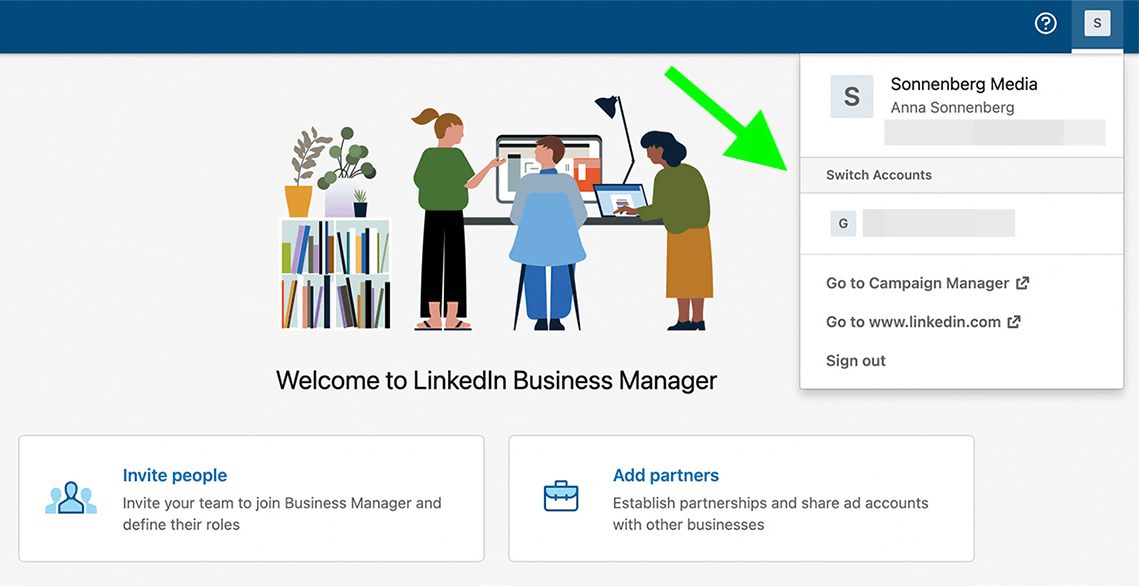
#3: Create a Business Manager
Once you’ve decided on an admin and mapped out a structure, you’re ready to create a Business Manager. To get started, go to the Business Manager creation page and enter the email address you want to link to the dashboard. It’s best to use a work email address for this purpose and it doesn’t have to match the email you use for your personal LinkedIn login.
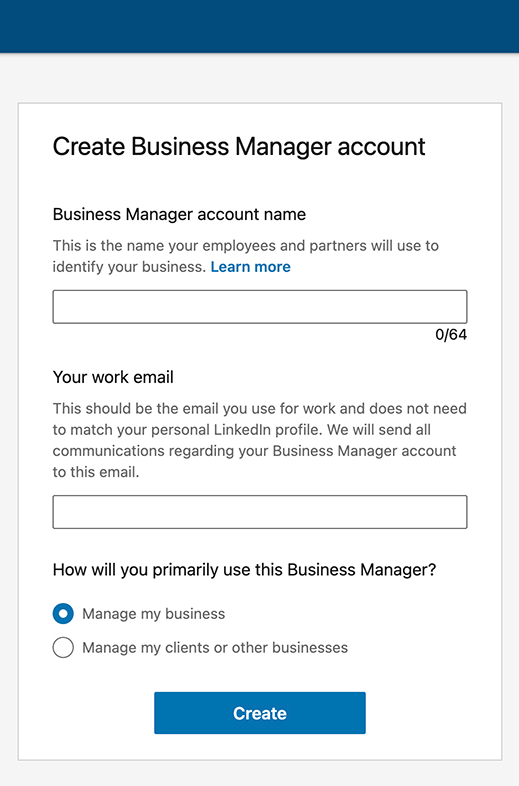
Then give the Business Manager a name. If you’re creating a single dashboard for an organization, it’s typically best to use your company name. If you’re planning to create multiple dashboards for different units or regions, use a consistent naming structure. Again, you can use your Meta Business Suite for inspiration.
Get World-Class Marketing Training — All Year Long!
Are you facing doubt, uncertainty, or overwhelm? The Social Media Marketing Society can help.
Each month, you’ll receive training from trusted marketing experts, covering everything from AI to organic social marketing. When you join, you’ll also get immediate access to:
- A library of 100+ marketing trainings
- A community of like-minded marketers
- Monthly online community meetups
- Relevant news and trends updates
Keep in mind that any colleagues or business partners you add will see the name of the Business Manager. To help them identify your dashboard efficiently, use a simple name that’s likely to resonate with everyone involved.
Before clicking Create, you also need to indicate the main purpose for the dashboard. Choose the option that best represents your planned usage: managing your own or clients’ business assets.
#4: Invite Team Members
Before you start adding pages and accounts to your Business Manager, it’s a good idea to invite your team. To add others, click the Invite People button in the upper-right corner and enter their work email address.
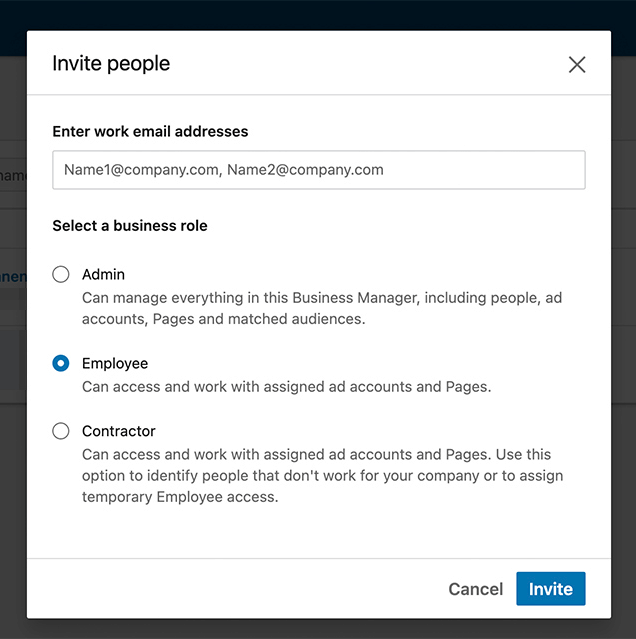
Even if one person will take responsibility for managing the dashboard, plan to designate at least two people with admin access. That way, your team can always use your organization’s Business Manager, even if one of you experiences access issues.
Then assign relevant roles to other team members. In most cases, internal employees should get Employee access, while external partners should get Contractor access. After inviting team members, you can manage their invitations by clicking the three dots to the right of their name.
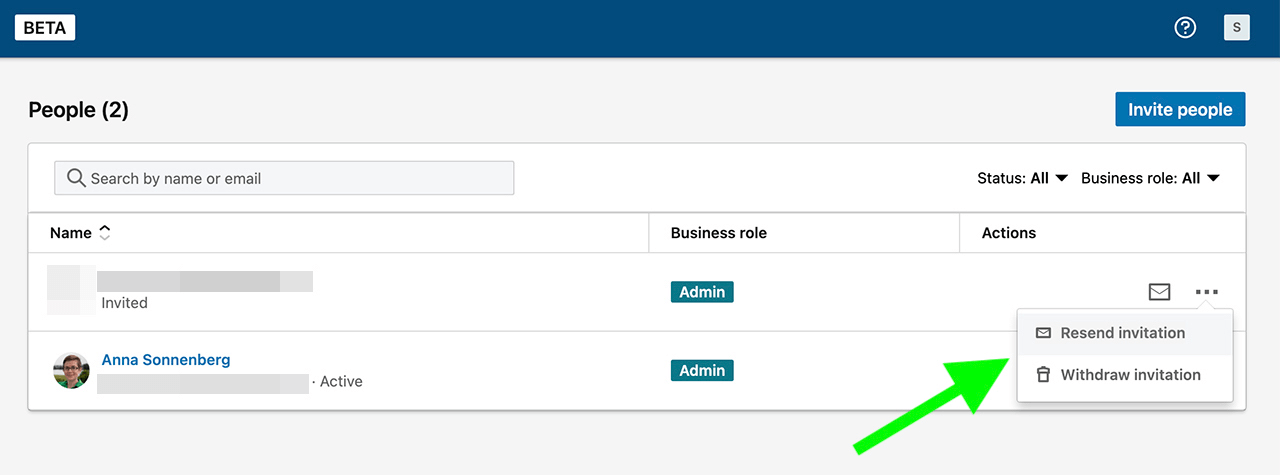
Once team members accept your invitation and join your Business Manager, you can moderate their role at any time. Go to the People tab and click the pencil icon to the right of any team member.
From there, you can add or change their title (for informational purposes only) or use the drop-down menu to assign a different business role. If you need to switch a team member from an admin role to an employee role, for example, this is the place to do it. We’ll cover permissions for specific pages and ad accounts below.
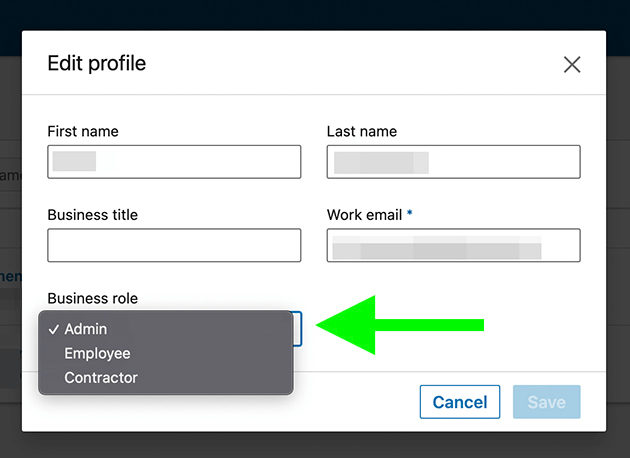
Are you wondering whether it’s really worth adding all of your colleagues to your Business Manager? If they currently have permission to manage your LinkedIn pages or ad accounts and need to continue to use these assets, you should add them to your Business Manager.
As of July 2022, LinkedIn has indicated that members will continue to be able to manage company assets through their personal profiles for a few months. But once Business Manager adoption increases and the transition period ends, they’ll have to manage all company assets through Business Manager.
#5: Link Pages to Business Manager
Next, add your organization’s assets to your Business Manager. Go to the Pages tab and open the Add Page drop-down menu. If you’re using the Business Manager to handle owned assets, select Add Page.
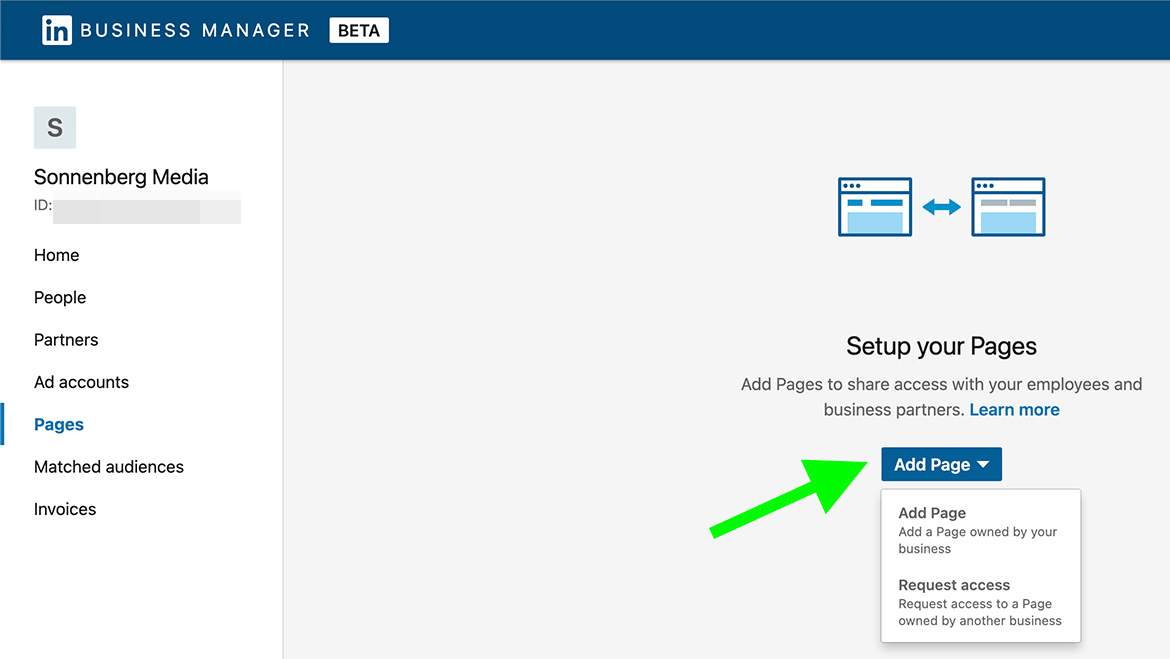
Then search for your company page. You can search by name or enter the URL for your page. Note that moving a page into Business Manager means you’ll need to manage admins from the dashboard going forward. If you agree to the terms, click Add.
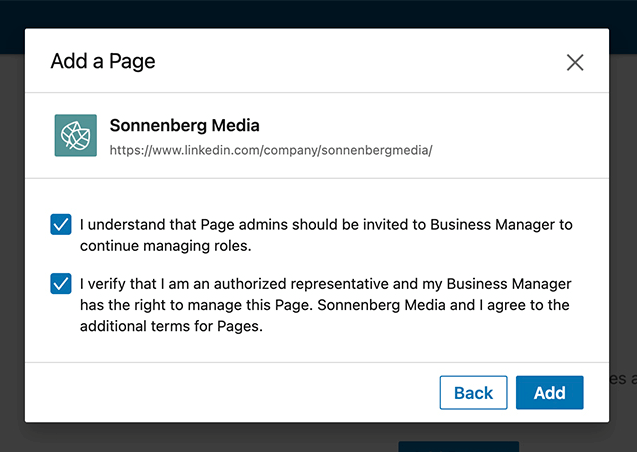
Note that you can only add a LinkedIn page if one of its super-admins is in your Business Manager already. For example, if you’ve only invited the page’s content admins to your Business Manager, you’ll need to invite a super-admin before linking the page.

Once you link a page, you should see it listed in your Business Manager. To view the admins who have access to it, click the name of the page or the View details option that pops up after clicking the three dots. Anyone who already has access through the page administration interface should automatically be listed here.

Discover Proven Marketing Strategies and Tips
Want to go even deeper with your marketing? Check out the Social Media Marketing Podcast! Publishing weekly since 2012, the Social Media Marketing Podcast helps you navigate the constantly changing marketing jungle, with expert interviews from marketing pros.
But don’t let the name fool you. This show is about a lot more than just social media marketing. With over 600 episodes and millions of downloads each year, this show has been a trusted source for marketers for well over a decade.
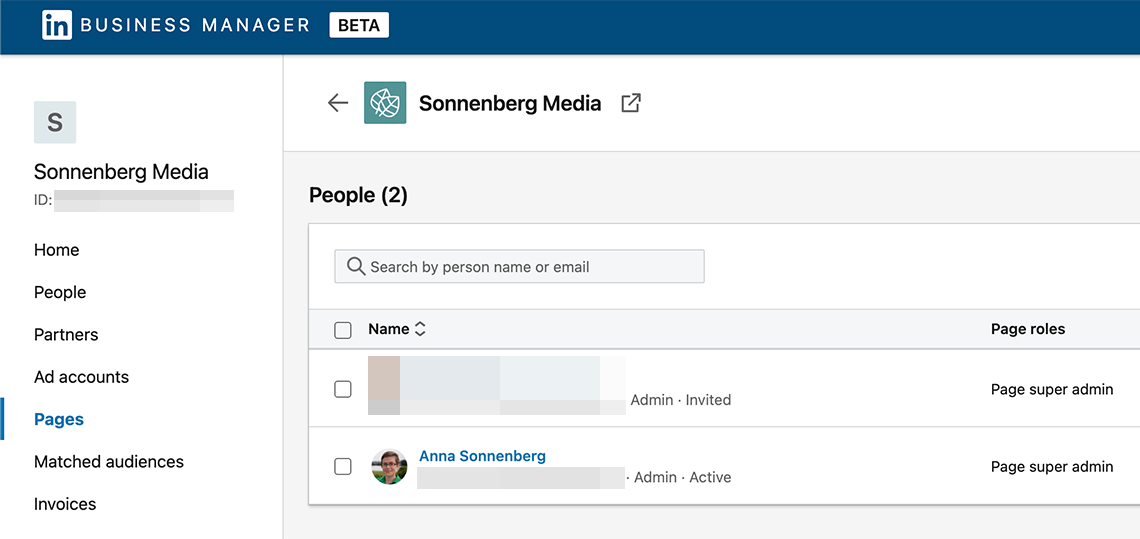
To manage the page, click the LinkedIn Page link. You’ll be redirected to the standard page management interface where you can create posts, write articles, and review analytics. As of July 2022, the workflow for creating company content and reviewing results hasn’t changed.
#6: Add Ad Accounts to Business Manager
The process for linking ad accounts to Business Manager is similar. Go to the Ad Accounts tab in Business Manager and click the Add Accounts button to view the drop-down menu.
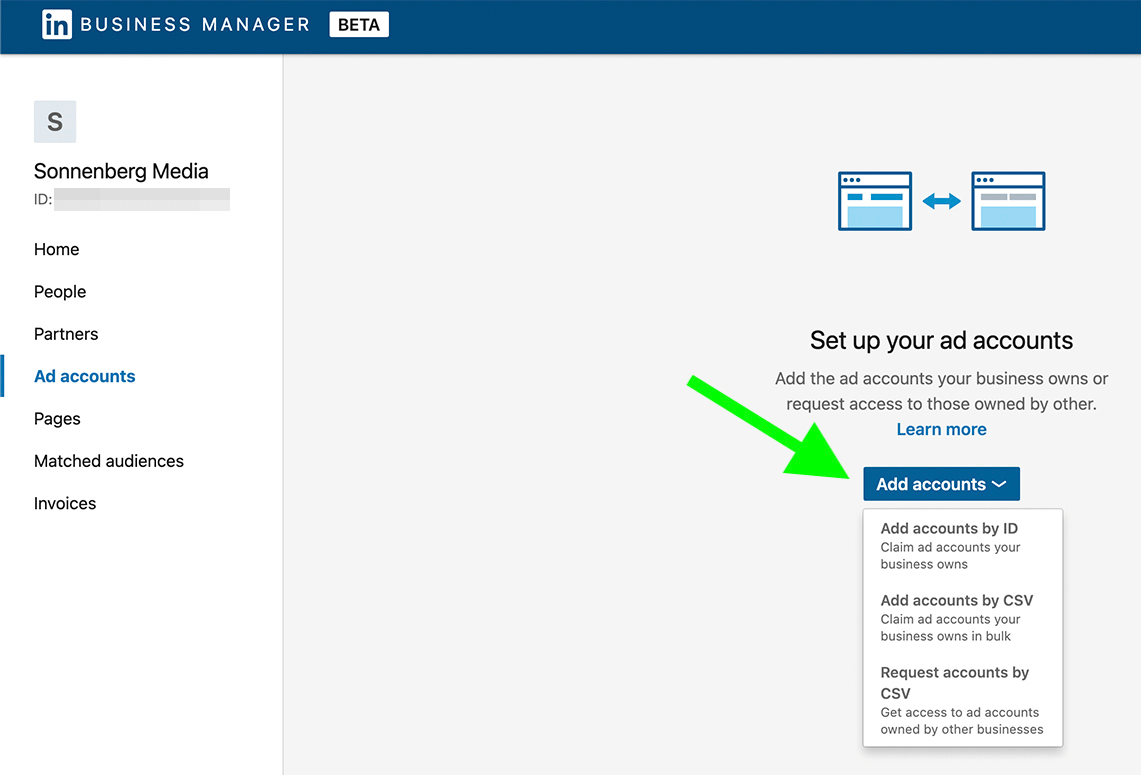
If you only need to add a handful of ad accounts, entering the ID is the most efficient option. But if you need to link more than a few, use the Add Accounts by CSV option instead.
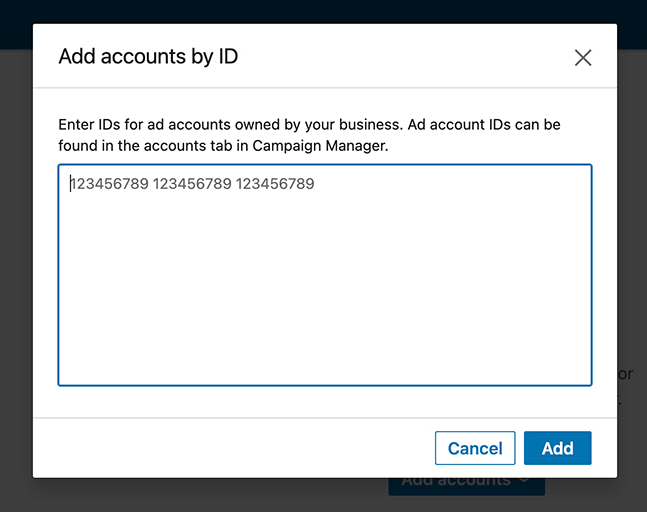
Once your request is approved, you’ll see the account listed in your Business Manager. To check its status and add team members, click the three dots to the right and select View Details. Similar to pages, anyone who already had access to your ad account should automatically be listed in Business Manager.
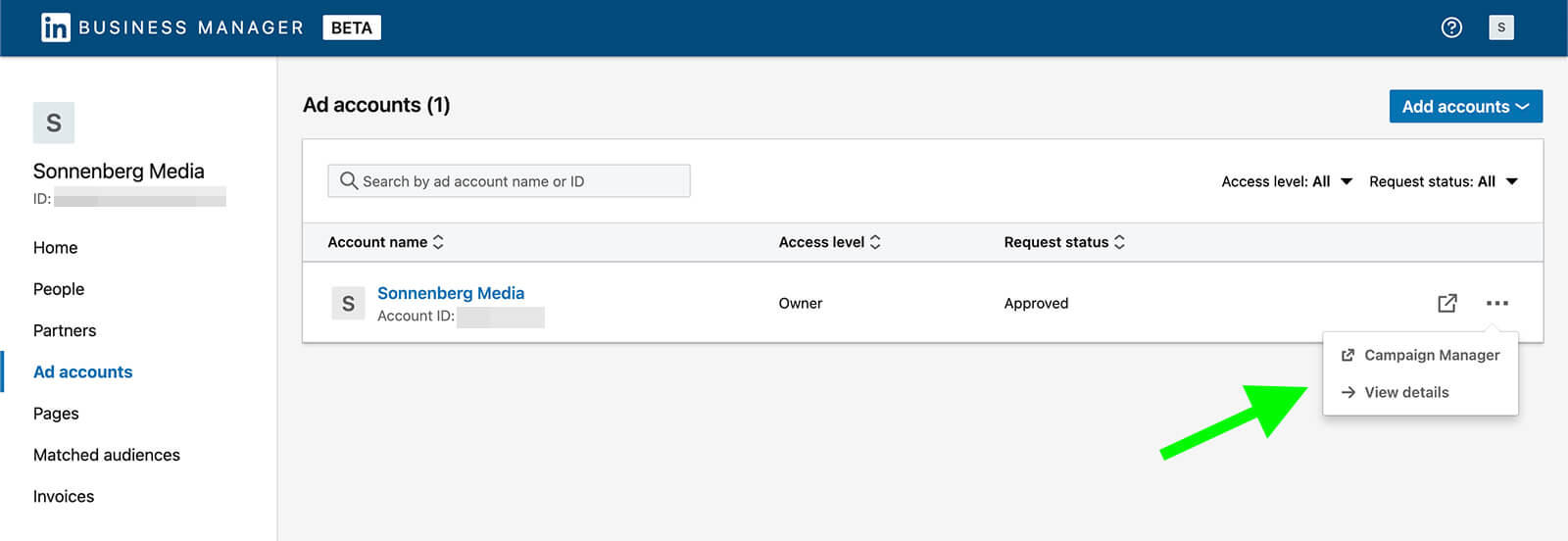
To edit a team member’s role, click the pencil icon to the right of their name. Then choose a new role and click the Update button.
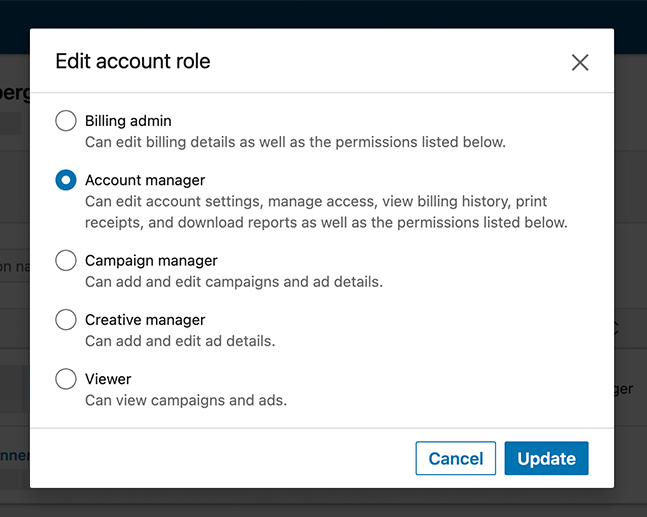
If you’d like to add more accounts, click the left arrow to go back to the main Ad Accounts tab. Then click the Add Accounts button in the upper-right and choose how you want to link your assets.
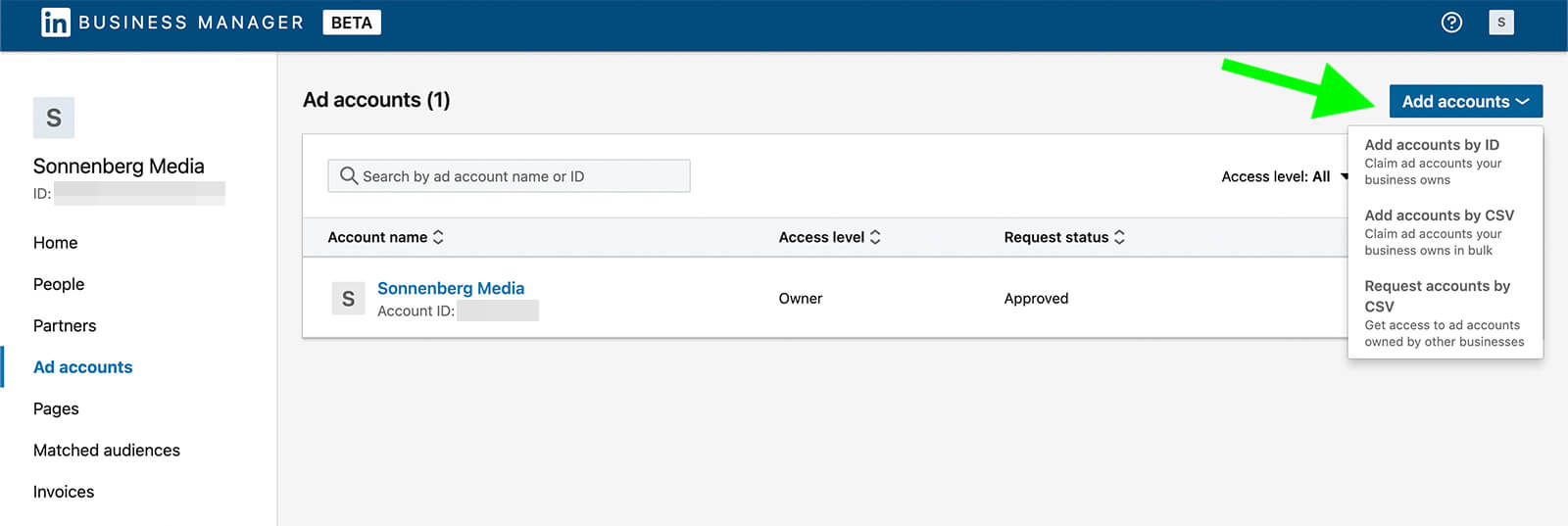
You can also open any account from the main Ad Accounts tab. Click the three dots to the right of the account and select Campaign Manager. Similar to LinkedIn pages, the interface for using ad accounts hasn’t changed. Although you can administer access in Business Manager, you’ll still create and analyze ads in Campaign Manager.
#7: Share Matched Audiences in Business Manager
When you link ad accounts to your Business Manager, any matched audiences automatically transfer. To view them, go to the Matched Audiences tab. You can open any matched audience to view the details.

To share it, check the box to the left of the matched audience and click the Share Audiences button in the upper right. Then select the ad account you want to share the audience with and click the Share button.
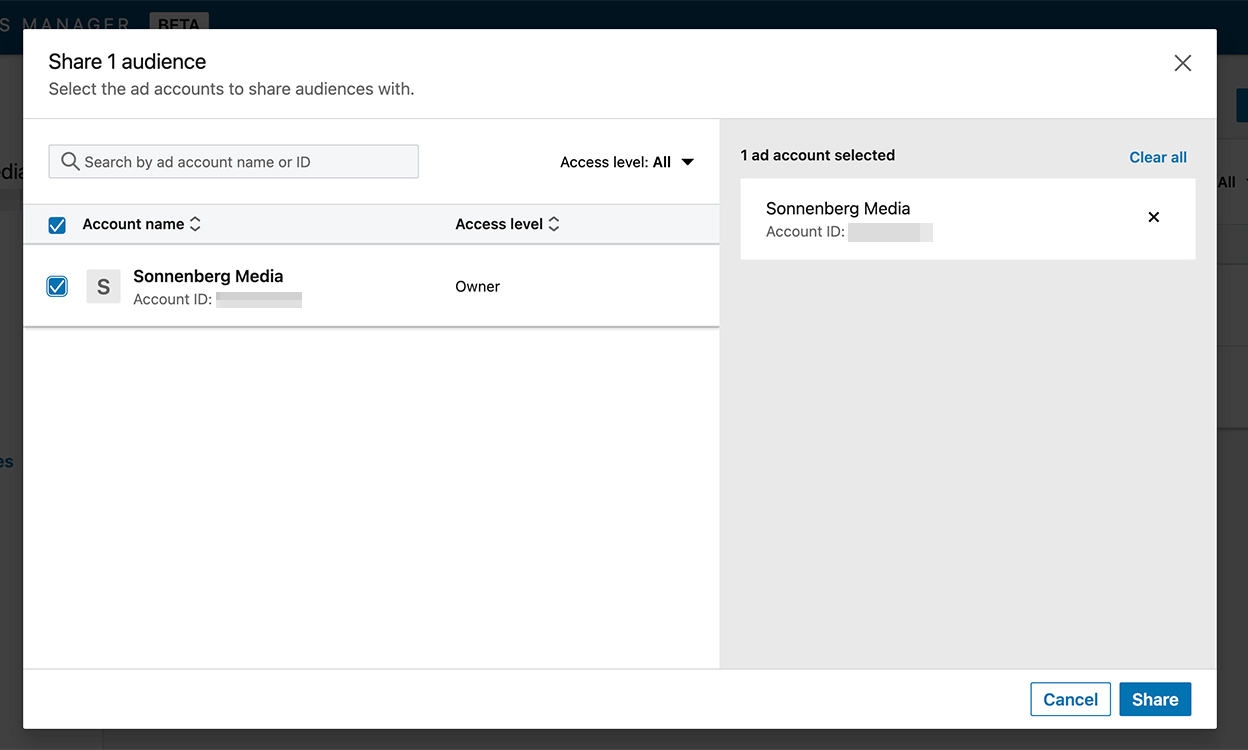
You can also click to open any matched audience directly in Campaign Manager. From there, you can edit any existing audiences or create new ones. Note that any new matched audiences you create in a linked ad account will automatically appear in Business Manager.
#8: Manage Team Members in Business Manager
Once team members have accepted your invitation to join your Business Manager, you can manage their profiles, roles, and status. To manage team members, go to the People tab.
To see which assets a team member can manage, click the three dots to the right of their name and select View details. Then toggle between the Pages and Ad Accounts tabs to see which assets they can access.
If you click on the three dots to the right of any page or ad account, you can see more management options. For example, you can remove access to assets or change permissions.
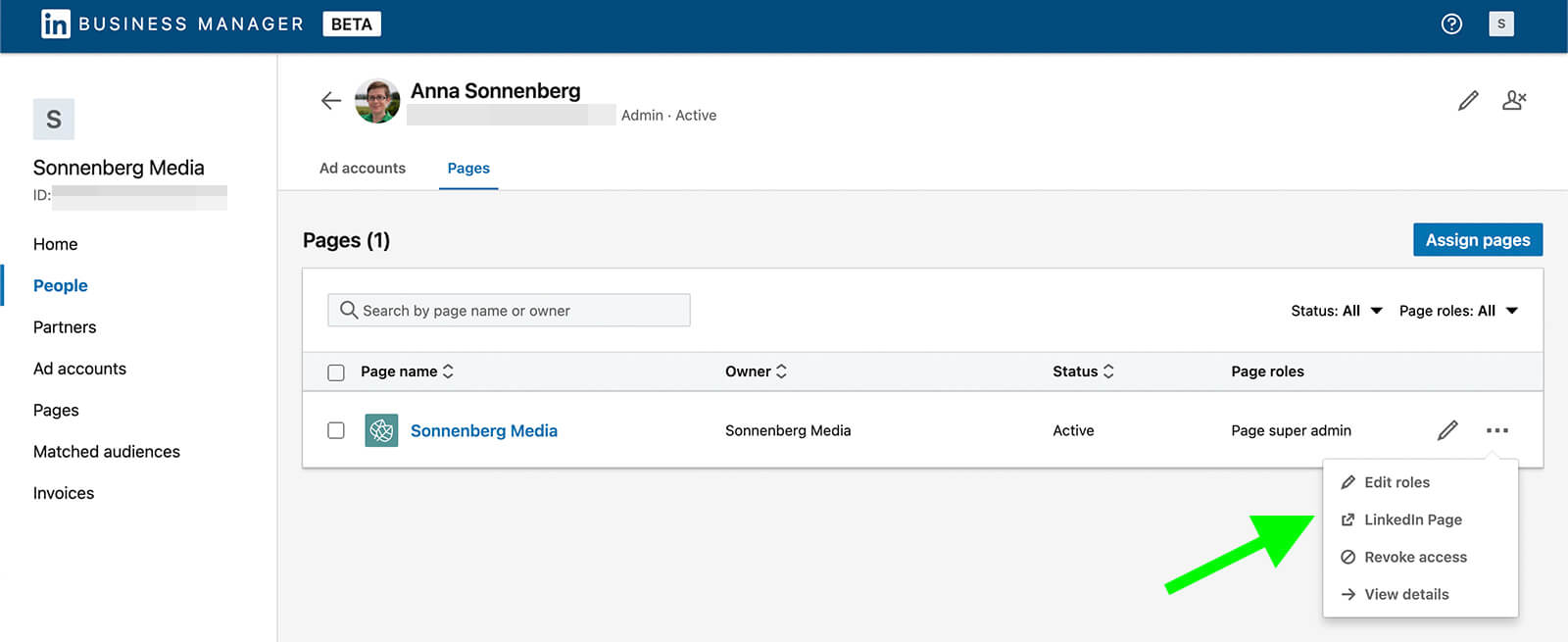
You can invite a team member to manage more pages directly from the People tab in Business Manager. View any team member and click the Assign Pages button in the upper-right corner. You’ll see a list of all of the available pages you can assign.
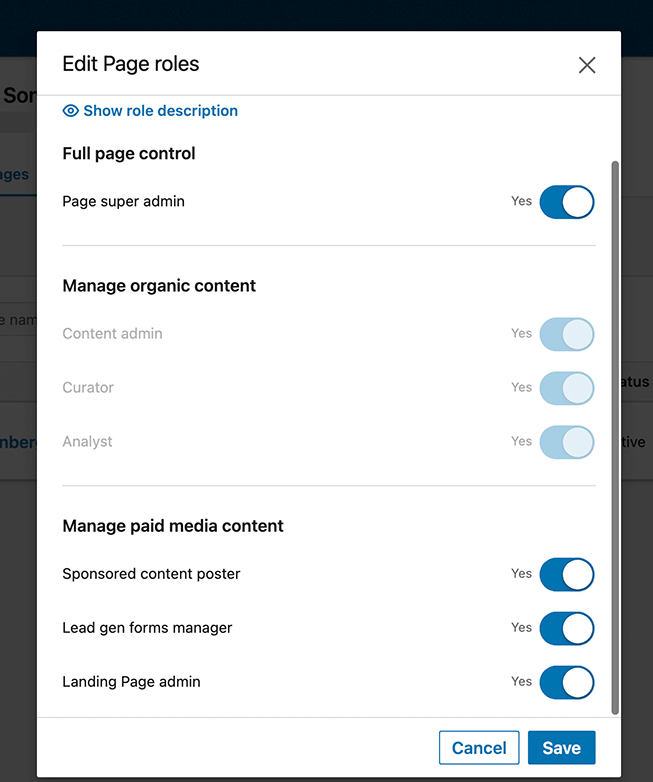
If you want to remove their access to a page instead, click three dots to the right of their name and select Revoke Access. You can also remove team members from the Pages tab. Select any company page, click the three dots to the right of their name, and choose Remove.
#9: Collaborate With Outside Partners and Stakeholders in Business Manager
Along with team members, Business Manager also supports external partners. You can invite individual consultants or freelancers using the workflow above. But if you’re planning to hire an agency with multiple employees or if you want a more secure option for collaborating with external contractors, partnerships are the way to go.
Before you start adding partners or requesting collaborators to add your team, make sure everyone is on the same page. Since Business Manager is a new tool, your business partners may not have transitioned to using it yet.
Only one Business Manager can own an ad account or a company page. That means the organization that owns it should move it into their Business Manager first, and then invite external partners to access it.
Then either Business Manager can initiate a partnership. All you need to establish a partnership is the other organization’s Business Manager ID. Go to the Partners tab in your Business Manager, add their Business Manager ID, and click Add Partner.
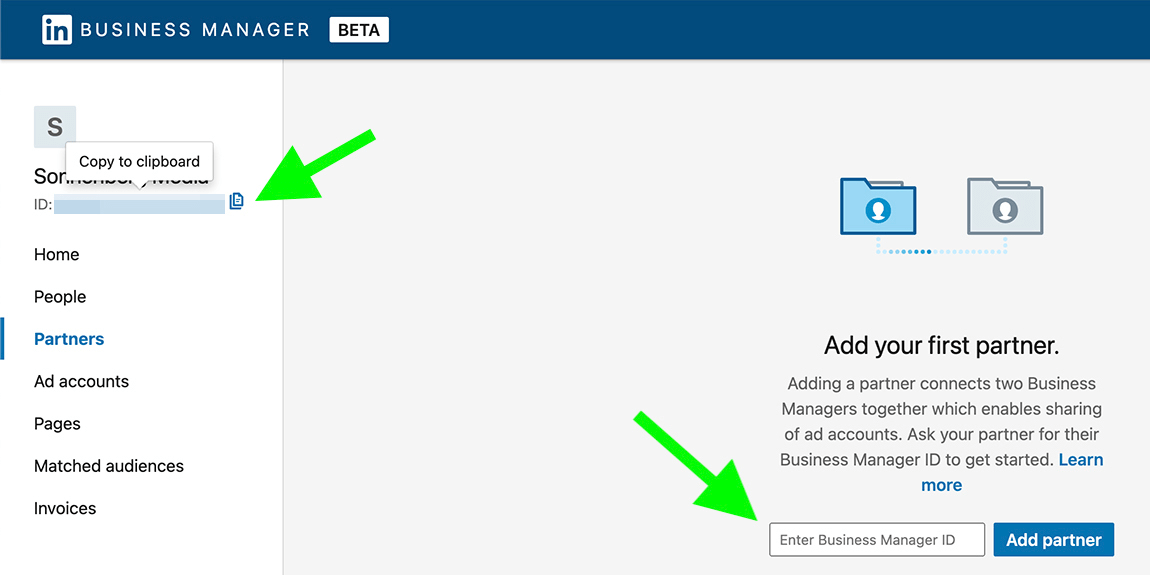
Once you add a partner, you can see the other Business Manager listed on the Partners tab. Click any partner to see the assets you’ve shared. Interestingly, a Business Manager partnership creates a two-way connection that allows either organization to add assets.
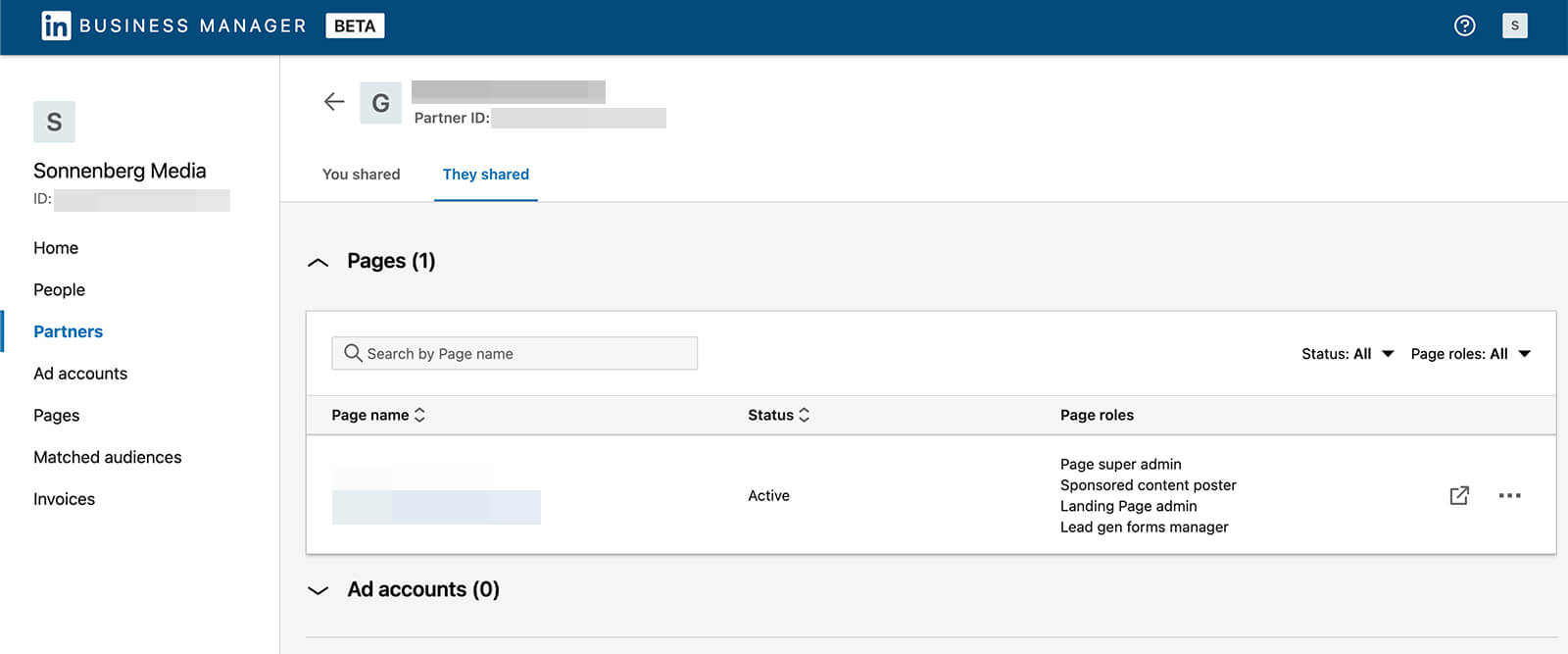
You can navigate between the You Shared and They Shared tabs to manage all of the assets that the two Business Managers have shared. On the You Shared tab, you can use the buttons on the right side of the screen to choose pages and ad accounts to share.

When you share access, you’ll see a prompt to give the partner organization an appropriate level of access. For example, you can allow a partner full page control, which means their employees can have super admin access.
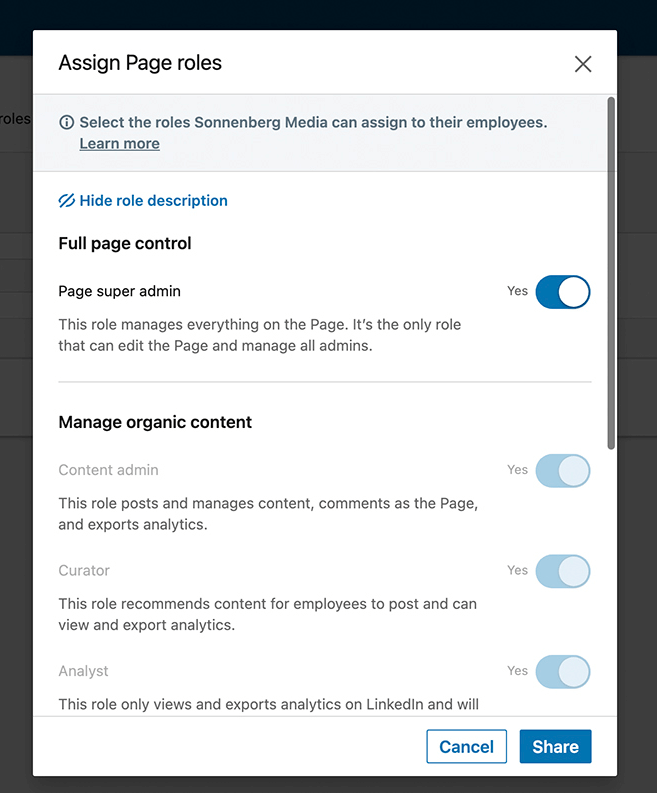
Once your partner has access to your ad account or page, they can manage access via the Partners tab. From there, they can assign roles to their own team members and click through to manage the assets in Campaign Manager or LinkedIn.
Conclusion
The public beta version of LinkedIn Business Manager offers efficient account management, seamless collaboration, and secure account sharing. As the platform continues to roll out planned features like billing and cross-account reporting, it’s likely to become an even more useful tool for social media marketers.
Stay Up-to-Date: Get New Marketing Articles Delivered to You!
Don't miss out on upcoming social media marketing insights and strategies! Sign up to receive notifications when we publish new articles on Social Media Examiner. Our expertly crafted content will help you stay ahead of the curve and drive results for your business. Click the link below to sign up now and receive our annual report!
Attention Agency Owners, Brand Marketers, and Consultants

Introducing the Marketing Agency Show–our newest podcast designed to explore the struggles of agency marketers.
Join show host and agency owner, Brooke Sellas, as she interviews agency marketers and digs deep into their biggest challenges. Explore topics like navigating rough economic times, leveraging AI, service diversification, client acquisition, and much more.
Just pull up your favorite podcast app, search for Marketing Agency Show and start listening. Or click the button below for more information.

